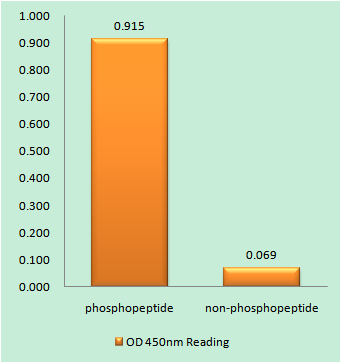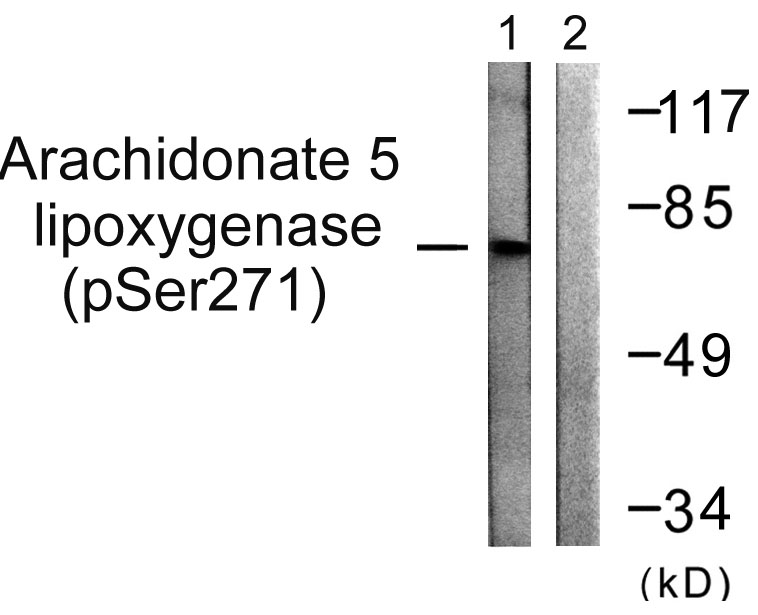5-LO (phospho Ser272) Polyclonal Antibody
- Catalog No.:YP0715
- Applications:WB;IHC;IF;ELISA
- Reactivity:Human;Mouse;Rat
- Target:
- 5-LO
- Fields:
- >>Arachidonic acid metabolism;>>Metabolic pathways;>>Fc epsilon RI signaling pathway;>>Serotonergic synapse;>>Ovarian steroidogenesis;>>Toxoplasmosis
- Gene Name:
- ALOX5
- Protein Name:
- Arachidonate 5-lipoxygenase
- Human Gene Id:
- 240
- Human Swiss Prot No:
- P09917
- Mouse Gene Id:
- 11689
- Mouse Swiss Prot No:
- P48999
- Rat Gene Id:
- 25290
- Rat Swiss Prot No:
- P12527
- Immunogen:
- The antiserum was produced against synthesized peptide derived from human Arachidonate 5 Lipoxygenase around the phosphorylation site of Ser271. AA range:246-295
- Specificity:
- Phospho-5-LO (S272) Polyclonal Antibody detects endogenous levels of 5-LO protein only when phosphorylated at S272.
- Formulation:
- Liquid in PBS containing 50% glycerol, 0.5% BSA and 0.02% sodium azide.
- Source:
- Polyclonal, Rabbit,IgG
- Dilution:
- WB 1:500 - 1:2000. IHC 1:100 - 1:300. ELISA: 1:10000.. IF 1:50-200
- Purification:
- The antibody was affinity-purified from rabbit antiserum by affinity-chromatography using epitope-specific immunogen.
- Concentration:
- 1 mg/ml
- Storage Stability:
- -15°C to -25°C/1 year(Do not lower than -25°C)
- Other Name:
- ALOX5;LOG5;Arachidonate 5-lipoxygenase;5-LO;5-lipoxygenase
- Observed Band(KD):
- 78kD
- Background:
- This gene encodes a member of the lipoxygenase gene family and plays a dual role in the synthesis of leukotrienes from arachidonic acid. The encoded protein, which is expressed specifically in bone marrow-derived cells, catalyzes the conversion of arachidonic acid to 5(S)-hydroperoxy-6-trans-8,11,14-cis-eicosatetraenoic acid, and further to the allylic epoxide 5(S)-trans-7,9-trans-11,14-cis-eicosatetrenoic acid (leukotriene A4). Leukotrienes are important mediators of a number of inflammatory and allergic conditions. Mutations in the promoter region of this gene lead to a diminished response to antileukotriene drugs used in the treatment of asthma and may also be associated with atherosclerosis and several cancers. Alternatively spliced transcript variants encoding different isoforms have been found for this gene. [provided by RefSeq, Jan 2012],
- Function:
- catalytic activity:Arachidonate + O(2) = leukotriene A(4) + H(2)O.,cofactor:Binds 1 iron ion per subunit.,cofactor:Binds 2 calcium ions per subunit.,function:Catalyzes the first step in leukotriene biosynthesis, and thereby plays a role in inflammatory processes.,pathway:Lipid metabolism; leukotriene A4 biosynthesis.,PTM:Serine phosphorylation by MAPKAPK2 is stimulated by arachidonic acid. Phosphorylation on Ser-523 by PKA has an inhibitory effect. Phosphorylation on Ser-272 prevents export from the nucleus.,similarity:Belongs to the lipoxygenase family.,similarity:Contains 1 lipoxygenase domain.,similarity:Contains 1 PLAT domain.,subcellular location:Shuttles between cytoplasm and nucleus. Found exclusively in the nucleus, when phosphorylated on Ser-272. Calcium binding promotes translocation from the cytosol and the nuclear matrix to the nuclear envelope and membrane association.,subun
- Subcellular Location:
- Cytoplasm . Nucleus matrix . Nucleus membrane ; Peripheral membrane protein . Cytoplasm, perinuclear region . Cytoplasm, cytosol . Nucleus envelope . Nucleus intermembrane space . Shuttles between cytoplasm and nucleus (PubMed:19233132). Found exclusively in the nucleus, when phosphorylated on Ser-272 (PubMed:18978352). Calcium binding promotes translocation from the cytosol and the nuclear matrix to the nuclear envelope and membrane association (PubMed:19233132, PubMed:3118366, PubMed:8245774, PubMed:16275640). .
- Expression:
- Brain,Spleen,
- June 19-2018
- WESTERN IMMUNOBLOTTING PROTOCOL
- June 19-2018
- IMMUNOHISTOCHEMISTRY-PARAFFIN PROTOCOL
- June 19-2018
- IMMUNOFLUORESCENCE PROTOCOL
- September 08-2020
- FLOW-CYTOMEYRT-PROTOCOL
- May 20-2022
- Cell-Based ELISA│解您多样本WB检测之困扰
- July 13-2018
- CELL-BASED-ELISA-PROTOCOL-FOR-ACETYL-PROTEIN
- July 13-2018
- CELL-BASED-ELISA-PROTOCOL-FOR-PHOSPHO-PROTEIN
- July 13-2018
- Antibody-FAQs
- Products Images

- Enzyme-Linked Immunosorbent Assay (Phospho-ELISA) for Immunogen Phosphopeptide (Phospho-left) and Non-Phosphopeptide (Phospho-right), using Arachidonate 5 Lipoxygenase (Phospho-Ser271) Antibody

- Immunohistochemistry analysis of paraffin-embedded human skeletal muscle, using Arachidonate 5 Lipoxygenase (Phospho-Ser271) Antibody. The picture on the right is blocked with the phospho peptide.

- Western blot analysis of lysates from HUVEC cells, using Arachidonate 5 Lipoxygenase (Phospho-Ser271) Antibody. The lane on the right is blocked with the phospho peptide.



